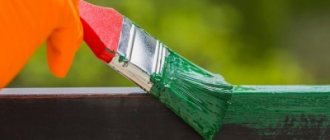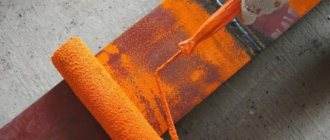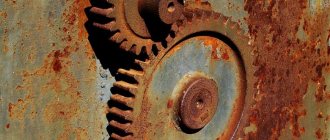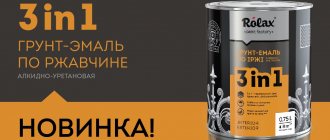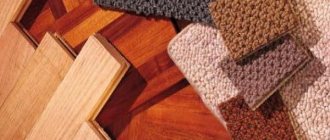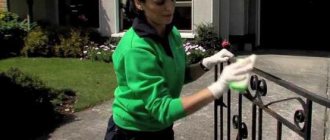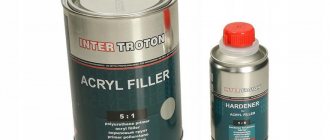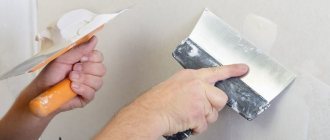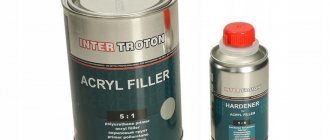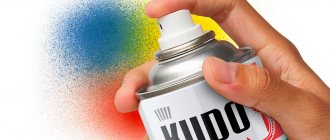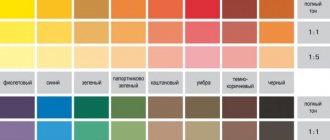Domestic primer-enamel for rust “3 in 1” Novbythim occupies a worthy place in the line of modern anti-corrosion and decorative coatings.
The experimentally tested chemical composition, clearly developed instructions for use, and many positive characteristics explain the high popularity of the product on the paint and varnish market.
Comparison with analogues, as well as user reviews presented in this article, allow us to evaluate the feasibility of choosing Novbytkhim 3 in 1 rust enamel primer.
Paint Features
The manufacturer of the product is JSC New Household Chemicals , known by the abbreviated name Novbytkhim. The company was founded in St. Petersburg in 1994.
The main direction of the company is the production of household and construction chemicals. The product range includes more than 60 items.
This number includes:
primers,- varnishes,
- enamel,
- adhesives,
- stains,
- putties,
- sealants,
- dyes.
The quality of the supplied products complies with GOST standards, which is confirmed by the Certificate of Conformity received by the company in 2013.
Primer-enamel “3 in 1” Novbythim against rust is one of the innovative developments of the St. Petersburg company. The emulsion performs three functions simultaneously:
- Blocks the corrosion process.
- Primes the surface.
- Creates a decorative coating.
Since primer enamel replaces three products at the same time, it is possible to reduce surface treatment time, reduce the labor intensity of the process, and at the same time obtain a presentable appearance of the product.
The manufacturer gives the emulsion the following characteristics:
- weatherproof;
- quick-drying;
- waterproof;
- elastic;
- heat resistant;
- economical.
Video description
Primer-enamel 3 in 1: the whole truth about durability.
In terms of color, the paint and varnish material is produced according to the main line of the RAL table, although these, of course, are not all of its shades, but only the main ones. Various manufacturers declare the service life of paint without changing the appearance: indoors - from 7 to 10 years, outside - from 5 to 7 years.
Note: it would not be amiss to mention that the 3 in 1 enamel primer is frost-resistant not only in the hardened state, but also in the liquid state, therefore, the paint can be stored at subzero temperatures.
How to make the right choice
Excellent enamel for rusty metal products in the middle price segment Source otzovik.com
On a can of paint of this type there may be some incomprehensible additions in the form of definitions of several words. Based on them, you can choose the most optimal 3-in-1 enamel primer for your situation:
- Converter. If such a word is mentioned in the characteristics, this means that this composition is able to prevent oxidation of the metal, the occurrence of rust, and at the same time restore the base damaged by these processes. The composition includes H₃PO₄ - this is colorless orthophosphoric acid.
- Passivating. Protects metal from oxidation and rust. Thanks to the anti-corrosive properties, structures treated with this paint can remain under water for a long time.
- Phosphating two-component. In this case, components with passivating and transformative properties are combined. Well suited for coating galvanized surfaces.
- Insulating. Promotes thermal and chemical resistance and performs well in aggressive environments.
- Protective. This is a decorative property obtained by adding metal dust. When painted, the surface acquires the characteristic structure of steel.
Most popular manufacturers
DALI produces an effective primer-enamel with a rust converter. It is noteworthy that many claim that this composition is odorless, but this is, to put it mildly, an exaggeration. All paints and varnishes of this kind emit a characteristic smell of a solvent (in this case, it is a solvent), therefore, it is not recommended to work with such paintwork materials in an unventilated area. Due to the covering power of the material, a durable film is formed on the treated surface that can withstand the effects of aggressive environments, ultraviolet irradiation and mechanical stress. DALI enamel has excellent adhesion to glyphthalic and pentaglyphthalic coatings (GF, PF).
Used for protecting and painting clean, rusty or partially corroded metal surfaces Source bafus.ru
Application area
Multicomponent primer-enamel Novbytkhim is allowed to be used for metal objects located indoors or outdoors. They can be either painted or unpainted. The product is ideal for application to rusty surfaces if the corrosion layer does not exceed 100 microns.
The scope of Novbythim is quite wide. It can be painted:
- fences,
- gratings,
- pipes,
- factory and warehouse equipment,
- metal structures of bridges and pipelines,
- car parts and body.
Primer enamel should not be used to cover heated surfaces indoors. If this rule is ignored, a specific unpleasant odor may appear. Objects previously painted with nitro enamel (NC) also fall under the taboo. The nitro paint coated on top with an anti-corrosion primer swells and peels off.
Useful tips
Difficulties that arise when using KUDO aerosol paints arise, as a rule, from inattentively reading the instructions for use or ignoring basic painting rules. The typical errors discussed below and methods for eliminating them allow even a not very prepared user to avoid problems and enjoy the painting process.
Changing Hue
When an aerosol can is stored for a long time, the pigments that give the paint its color tend to settle at the bottom. The mistake consists of shaking the container insufficiently or for a short time. The contents are not mixed to a uniform emulsion, which is why the above problems occur. Solution to the problem: try, according to the instructions, to vigorously shake the container for 2 - 3 minutes.
Valve clogged
After previous use, the aerosol can was not turned over to clear the spray head, resulting in the paint drying out in the spray head channel. Solution to the problem: try to find a new spray head (it is not possible to dissolve the paint that has dried in the head), but it is better not to forget about purging.
The contents of the cylinder do not splash out
The can may be spraying upside down or the deviation from vertical is more than 45°. In this case, the gas - the propellant - escapes from the cylinder without displacing the paint. Solution: return the aerosol can to a vertical position or rotate it at a slight angle along the longitudinal axis of the can.
The storage time is too long and exceeds the shelf life of aerosol packaging. Unfortunately, there is no solution to this problem.
Spray paint does not cover the surface being painted well
The distance to the surface to be painted is incorrect. Most of the paint becomes dusty and does not settle on the surface to be painted.
Solution to the problem: try to choose the optimal distance to the surface under the given painting conditions.
Low ambient temperature.
Solution: Avoid painting in low temperatures, rainy or humid weather.
When painting, the surface becomes covered with a layer of small grains of sand and other foreign inclusions.
Painting occurs outdoors in windy weather or the content of suspended dust in the air is too high. Solution: Try to find a well-ventilated, but not drafty, area to paint in, or try to paint in calm weather.
The surface to be painted has been poorly cleaned of dust or retains significant static tension, attracting dust. Solution to the problem: try to more thoroughly clean the surface from dust and remove static voltage by grounding the product being painted.
When painted, the surface becomes covered with defects similar to craters
The surface is not well cleaned of individual stains of wax, fats, silicones, and polishing agents. Solution to the problem: thoroughly degrease the surface using KUDO Silicone Remover, after testing it on an inconspicuous area of the part to be painted, especially if painting will be done over old paintwork. The fact is that some types of enamels can dissolve under the influence of Silicone Remover.
The surface to be painted has an uneven shine, with glossy areas interspersed with matte areas
The paint is applied to an overly porous surface and is instantly absorbed. Solution to the problem: porous surfaces must be primed in several (2-3) layers. Use KUDO aerosol universal primer for priming.
The painted surface becomes covered with pronounced swellings and wrinkles.
Painting occurs with enamel that is incompatible with previously applied paints and varnishes. Solution to the problem: completely remove the old paintwork mechanically or using KUDO old paint remover.
Smudges form on the surface to be painted
(this defect forms mainly on vertical planes).
Too thick a layer of paint is applied. Solution to the problem: try to avoid overwatering, follow the instructions, try to paint in two or three layers with the recommended drying time between coats.
Coloring occurs too close. Solution to the problem: try to paint from the distance recommended by the instructions - 25-30 cm from the surface to be painted.
Coloring occurs at ambient temperatures below those recommended by the instructions. Solution to the problem: follow the instructions, do not try to paint at ambient temperatures below +10 ° C
Small bubbles form on the horizontal surface to be painted
Too thick a layer of paint is applied. Solution to the problem: try to avoid overwatering, follow the instructions, try to paint in two or three layers with the recommended drying time between coats.
The surface to be painted is too hot. Solution to the problem: try to ensure that the temperature of the surface to be painted matches the ambient temperature (it is advisable to paint in the shade). Remember that painting objects that are too hot can cause the paint to catch fire.
Shagreen and cracking form on the surface to be painted (this defect most often appears on horizontal planes).
Too thick a layer of paint is applied to a surface that is too hot. Solution to the problem: try to avoid overwatering, follow the instructions, try to paint in two or three layers with the recommended drying time between coats. Make sure that the temperature of the surface to be painted matches the ambient temperature (it is advisable to paint in the shade). Remember that painting objects that are too hot can cause the paint to catch fire.
Numerous smudges and unpainted spots are visible on the surface after painting.
Painting occurs on a wet or condensate-containing surface. Solution: Paint only dry surfaces. Follow the instructions, do not try to paint at ambient temperatures below +10°C, as a warm part taken out into the cold begins to become covered with condensation.
Composition of the product
The primer-enamel formula was developed in Novbythima's own chemical laboratory. The final composition includes several artificial components:
- synthetic resins;
- plasticizer;
- corrosion blockers;
- healthy supplements;
- solvents.
Solvents of organic origin are used in paint emulsions. This can be toluene, acetone or xylene. Corrosion inhibitors contain pigments that determine the color of the primer.
The multicomponent composition determines the long shelf life of the packaged primer-enamel. It is 36 months from the date of production.
Product line
The range of Novbytkhim paints and varnishes, which combine the “3 in 1” function, includes 11 shades. In addition to the classic white and black colors, the palette includes:
- grey,
- dark grey,
- brown,
- brown-red,
- red,
- ocher,
- yellow,
- dark green,
- blue.
Colored, black and white primer enamels give a matte effect after drying.
In addition to the universal primer-enamel “Novbythim” for rust “3 in 1”, the manufacturer offers several similar products that differ in composition and application. The catalog includes “3 in 1” primer-enamel latex “Chief Technologist”, as well as anti-corrosion enamel for metal “Chief Technologist”.
Primer-enamel for rust 3 in 1: features and application
The 3-in-1 rust enamel primer is an effective means of prevention and long-term protection against corrosion for steel and galvanized metal structures. The components included in this coating ensure the chemical transformation of rust into the soil, thanks to which it can be applied to the metal surface over the rust, which helps reduce the cost and time of work.
The resulting coating protects the metal surface from moisture, dirt, chemicals, and petroleum products, while withstanding significant temperature changes.
The numbers “3 in 1” mean that the coating performs three functions: 1. A rust converter that reacts with oxidized metal and stops the development of corrosion. 2. Primer that has good adhesion to the metal surface, including galvanized and stainless steel structures. 3. Durable enamel, resistant to scratches and various impacts.
Advantages of primer-enamel 3 in 1
Let's consider the main characteristics that make the use of this coating profitable and convenient:
- Quick application in 1 pass.
- Low consumption per 1 m2.
- Can be applied at temperatures as low as -20 C.
- Fast drying time.
- Tinting in the required colors according to RAL (white, gray, black, blue, green, red, brown), providing a beautiful appearance.
- Possibility of use without additional finishing coating.
- Possibility of application by any available method: brush, roller, airless spray.
- Resistant to temperatures from -50 to +100 C.
- For building metal structures, KRON PR primer-enamel can be used as a primer coating, optimized for subsequent application of fire-retardant paint on metal.
Below we will look at the performance and characteristics of 3 in 1 primer-enamel using the example of the KRON PR composition.
Application restrictions
It is not recommended to use enamel primer:
- For application over scale on metal.
- On top of loose rust.
- For painting metal structures or industrial equipment exposed to extreme heat.
- For application on nitro varnish coatings or old paint layers.
- For application to surfaces in contact with food or drinking water.
Application conditions
Rust enamel primer is intended for exterior, outdoor and interior work, and is applied under the following conditions:
- Temperature range: -20 C to +50 C.
- Air humidity: not higher than 85%.
- Application on surfaces with traces of moisture, ice, snow or frost is not allowed.
- The structures being treated must be protected from rain and snow.
- The surface for applying primer-enamel must be dry, free of fragile rust, old paint and varnish coatings, dirt, grease and dust.
Let's take a closer look at preparing the metal surface for applying primer-enamel, since the durability of the coating depends on the quality of this work.
Surface preparation of metal structures
The name primer-enamel does not imply that it can cover and neutralize any rust. Before applying primer-enamel, loose, fragile and flaking rust must be removed from the rusted metal surface using metal brushes, grinding machines or abrasive jet cleaning.
In the same way, the metal surface must be cleaned of old paint and varnish coatings, including anti-corrosion, fire-retardant or decorative ones.
Degreasing: removal of grease, oils, grease, dirt is carried out using washing solutions or solvents and wiping materials. When washed with water, its residues are removed with squeegees, compressed air, and construction hair dryers.
Dust and other foreign particles are removed using compressed air.
Control of surface cleaning of metal structures is carried out visually.
Preparation of the composition and how to dilute the primer-enamel for rust
Before use, the composition must be thoroughly mixed until completely homogeneous. In this case, there should be no sediment left at the bottom of the container.
To achieve the required degree of viscosity, you can dilute the enamel primer over rust using the following solvents:
- orthoxylene,
- R-646.
It is allowed to add solvent in an amount of no more than 5-7% by weight of the primer-enamel.
Rules for applying primer-enamel to a metal surface
1. Primer-enamel can be applied to the surface of metal structures in one of the following ways: - using a brush or roller, - using a pneumatic spraying apparatus, - using airless spraying units. 2. The composition can be applied in 1 or 2 layers. 3. When applied with a brush or roller, the thickness of one layer of primer-enamel is 35-45 microns. 4. When applied by airless spraying, the thickness of one dry layer is up to 120 microns, due to the high amount of dry residue. 5. Before applying the next layer, the previous layer must be completely dry. Drying time should be at least 4 hours, for a temperature of +20°C and humidity up to 75%. As the temperature decreases or humidity increases, the drying time increases.
Consumption rate of primer-enamel 3 in 1
Primer-enamel for rust 3 in 1 has the following consumption rates per 1 m2, depending on the method of application to the metal and the thickness of the dry layer:
- application by brush or roller, for a dry layer thickness of 20-30 microns: 80 g.
- application with a spray gun, for a dry layer thickness of 40 microns: 100-120 g.
- application by airless spray, for a dry layer of 60-80 microns: 250-300 g.
These figures do not take into account losses during painting.
If you have questions, you can ask them in the online chat or by phone +7 (495) 799-97-05.
The instructions apply to 3 in 1 primer-enamel for metal KRON PR.
You may also be interested
| Structural fire protection of metal structures of buildings |
| Technology for applying fire protection to metal structures - instructions for processing with water-based fire retardant paint |
| Instructions for applying frost-resistant fire retardant paint KRON SW - fire protection of metal at subzero temperatures |
| Passive fire protection of cables with thin-layer fire-retardant coatings |
| Methods of fire protection of metal structures |
Instructions for use
To obtain a high-quality result, it is important to adhere to the technology recommended by the developer. If you deviate from it, problems with coating adhesion and corrosion protection may occur.
The surface treatment algorithm includes several points:
- The product is washed from dirt, dust, and grease stains.
- Rusty deposits are removed mechanically.
- Clean off all the old peeling paint.
- Clean the previous layer of paint until it is matte.
- Degrease the surface to be treated.
- Dilute the primer-enamel to the desired consistency.
- Apply Novbytkhim to the prepared area.
- The fresh coat is left to dry for one hour.
- Apply primer enamel a second time.
- Leave for two hours to dry completely.
You can paint products using a brush, foam roller or paint sprayer. In the latter case, the primer-enamel must be made more liquid. This will help create an even, thin layer.
For effective and economical application, the consumption rate should be taken into account; it is 80-120 g/sq.m. for a single-layer coating .
To dilute Novbytkhim enamel, use a proprietary xylene-based product, Thinner No. 1, or solvents R-4, R-5. These liquids can also be used to wash soiled objects, brushes, rollers and other tools.
All work with Novbytkhim primer-enamel must be carried out at a temperature not lower than -10 and not higher than +30 degrees.
If the metal was previously painted with an NC composition, then the paint must first be completely cleaned off . If there are doubts about the quality of primer-enamel adhesion, it is recommended to conduct a test before completely painting the entire product. To do this, apply the product to a small locus, wait until it dries completely and check the quality of the coating.
If swollen bubbles are observed, it means that the old paint must be stripped to zero. If necessary, it is allowed to apply other paint emulsions on top of the dried Novbytkhim primer-enamel.
It can be:
- oil,
- water-dispersed,
- PF, HV paints and enamels.
Where and at what price to buy?
Enamel primer from Novbythim is sold on the company’s official website, in the centers of partner companies, hardware and construction stores, and online stores. JSC "New Household Chemicals" distributes its products throughout all regions of Russia and neighboring countries.
Primer enamel goes on sale in different packaging:
- cans 0.4 l.
- 1 liter jars
- cans 3 l.
- Euro bucket 20 l.
- barrels 200 l.
By agreement with the customer, Novbytkhim meets the wishes and packages paint and varnish products in other convenient containers.
The price of the product depends on the volume of the container , the cost of the anti-corrosion agent and the financial policy of the distributors. It is 300-400 rubles for a liter jar, 900-1100 rubles for a three-liter jar. For larger containers and for bulk purchases, a reduction factor applies. Prices can be viewed here.
Top 3 analogues
Products that combine a rust converter, primer and decorative enamel are produced by many foreign and domestic manufacturers.
An alternative to Novbythim can be no less effective and high-quality anti-corrosion paints:
- Prestige. A Russian-made product produced by. Primer enamel has a longer final drying time compared to Novbytkhim (6 hours) and a slightly higher consumption (125-180 g/sq.m.). But Prestige wins due to its lower cost: a two-liter jar costs about 400 rubles, a five-liter jar costs 1,400 rubles (prices here).
- Dali. The developer and supplier of primer enamel is LLC NPP Rogneda. Before use, the painted product is dried for 7 hours. The advantages of the product include economical consumption - up to 100 g/sq.m. and a wide color range in the line of smooth and hammer enamels. The downside of Dali is the price: a 2-liter jar costs 1200-1400 rubles, a 10-liter container costs 5800-6600 rubles (prices here).
- Lakra. Primer enamel is characterized by a long drying period (10 hours). However, other indicators coincide with Novbytkhim. So, the consumption is within the limit of 80-120 g/sq. meter, and the price for a 0.8-liter jar is on average 400 rubles (prices are here).
Review of popular manufacturers
Today there are many different anti-rust paints on the construction market; let’s look at the highest quality and most popular ones:
- Novbytkhim is one of the most popular products, which is characterized by high coating adhesion. This composition is sold in cans with a capacity of one to twenty liters and has low consumption. The price of such material is about 300 rubles.
- Lakra - produced in small containers weighing 1 and 2 kilograms. It has a small variety of colors, but effectively removes rust. Creates an even and smooth coating.
- Prestige - produced in Russia, this composition is distinguished by excellent technical characteristics and high quality. Users especially note the anti-corrosion properties of the material and ease of application.
- Dali - this composition is popular because it can be used to perform both facade and interior work. The paint has a hammer effect and dries quickly. This coating is resistant to moisture and mechanical stress.
- Tex – applicable for any type of work, creates a semi-glossy finish. The paint is produced in containers from 1 to 10 liters and has low consumption.
- Rainbow - used to cover clean and rust-damaged substrates, performing a decorative function.
Reviews
Different products produced by the company deserve different ratings from users. In general, the products are characterized as high quality, effective and meeting the stated requirements.
Users evaluate the “3 in 1” primer enamel differently, only 45% of them believe that it is worthy of a recommendation for purchase and use .
The positive aspects include price, paint quality, durability, efficiency, durability and good rust paintability even without thorough cleaning. The disadvantages of enamel include a strong pungent odor, which indicates its toxicity.
Consumers who gave negative reviews report a very unpleasant odor that can be felt even when working outside. The product has poor adhesion to the surface and low washability of brushes from paint residues.
You will find all the most important and interesting things about 3-in-1 rust-resistant primers in this section.
Advantages and disadvantages
Let's consider the advantages of this composition:
- affordable price;
- high adhesion;
- resistance to temperatures and moisture;
- high elasticity and strength;
- multifunctionality - there is no need to use a primer;
- versatility;
- resistance to mechanical stress;
- resistance to atmospheres;
- ease of application;
- short drying time;
- protecting the material from rust;
- excellent decorative properties;
- high painting properties;
- excellent hiding power;
- no shrinkage.
In user reviews, among the shortcomings of rust enamel, only the sharp unpleasant odor of the composition is noted, which does not dissipate for a long time.
